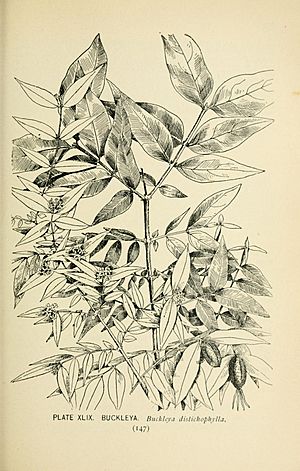Piratebush facts for kids
Quick facts for kids Piratebush |
|
|---|---|
 |
|
| Conservation status | |
| Scientific classification | |
| Genus: |
Buckleya
|
| Species: |
distichophylla
|
| Synonyms | |
|
|
The piratebush (scientific name: Buckleya distichophylla) is a unique flowering plant. It belongs to the Santalaceae family. This plant is quite rare. You can only find it in certain mountain areas. These areas are in the Southern United States, specifically North Carolina, Tennessee, and Virginia.
Contents
What is Piratebush?
The piratebush is a deciduous shrub. This means it loses its leaves each year. It can grow up to 15 feet (4.6 m) tall. Its leaves are usually 2 to 4 inches long. These leaves need direct sunlight to grow well.
How Piratebush Survives
What makes the piratebush special is how it gets its food. Most plants make all their food using photosynthesis. This process uses sunlight, water, and air. Piratebush leaves are pale green. This shows they have less chlorophyll than other plants. Chlorophyll is what helps plants make food.
Because of this, piratebush does not rely only on photosynthesis. It also gets nutrients by being a "hemiparasite." This means it partly lives off other plants. It attaches itself to the roots of nearby plants. It uses special structures called haustoria. These structures help it draw water and nutrients from the host plant.
Scientists first thought piratebush only attached to hemlock trees. But now we know it can connect to many different types of plants.
Where Piratebush Lives
Piratebush is a very rare plant. So far, it has only been found in the mountains. These areas are in North Carolina, Tennessee, and Virginia.
Poor Mountain's Special Role
The largest group of piratebush plants is on Poor Mountain. This mountain is part of the Poor Mountain Natural Area Preserve. It is about 2 miles (3.2 km) southwest of Roanoke in Roanoke County, Virginia. There are more piratebush plants on Poor Mountain than in all other known places combined.
Scientists are still trying to understand why this plant is so rare. Many other places in the Appalachians seem like good homes for piratebush. Yet, it grows in very few spots.
Discovery of Piratebush
The piratebush was first found a long time ago. In 1818, Thomas Nuttall discovered it. He found it along the French Broad River in Western North Carolina. He thought it was a type of plant in the olive family. He named it Borya distichophylla.
Later, in 1843, the plant was found again. This time, Samuel Buckley rediscovered it. Then, John Torrey studied the plant. He gave it the name Buckleya distichophylla. This is the name it still has today.


